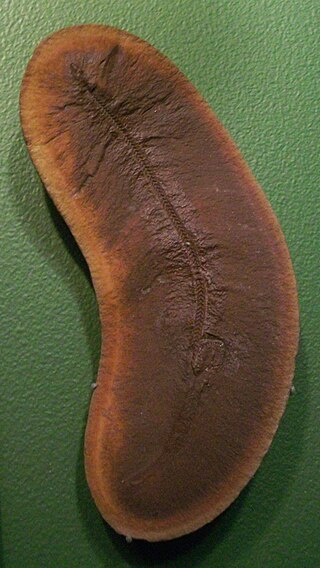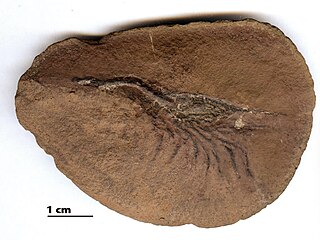Related Research Articles

Nectocaris is a genus of squid-like animal of controversial affinities known from the Cambrian period. The initial fossils were described from the Burgess Shale of Canada. Other similar remains possibly referrable to the genus are known from the Emu Bay Shale of Australia and Chengjiang Biota of China.

Tullimonstrum, colloquially known as the Tully monster or sometimes Tully's monster, is an extinct genus of soft-bodied bilaterian animal that lived in shallow tropical coastal waters of muddy estuaries during the Pennsylvanian geological period, about 300 million years ago. A single species, T. gregarium, is known. Examples of Tullimonstrum have been found only in the Essex biota, a smaller section of the Mazon Creek fossil beds of Illinois, United States. Its classification has been the subject of controversy, and interpretations of the fossil have likened it to molluscs, arthropods, conodonts, worms, tunicates, and vertebrates. This creature had a mostly cigar shaped body, with a triangular tail fin, two long stalked eyes, and a proboscis tipped with a mouth-like appendage. Based on the fossils, it seems this creature was a nektonic carnivore that hunted in the ocean’s water column. When Tullimonstrum was alive, Illinois was a mixture of ecosystems like muddy estuaries, marine environments, and rivers and lakes. Fossils of other organisms like crustacean Belotelson, the cnidarian Essexella, and the elasmobranch fish Bandringa have been found alongside Tullimonstrum.
The Mazon Creek fossil beds are a conservation lagerstätte found near Morris, in Grundy County, Illinois. The fossils are preserved in ironstone concretions, formed approximately 309 million years ago in the mid-Pennsylvanian epoch of the Carboniferous period. These concretions frequently preserve both hard and soft tissues of animal and plant materials, as well as many soft-bodied organisms that do not normally fossilize. The quality, quantity and diversity of fossils in the area, known since the mid-nineteenth century, make the Mazon Creek lagerstätte important to paleontologists attempting to reconstruct the paleoecology of the sites. The locality was declared a National Historic Landmark in 1997.

The Thylacocephala are group of extinct probable mandibulate arthropods, that have been considered by some researchers as having possible crustacean affinities. As a class they have a short research history, having been erected in the early 1980s.
Pohlsepia mazonensis is a species of fossil organism with unknown affinity. Although it was originally identified as an extinct cephalopod, later studies denied that interpretation. The species is known from a single exceptionally preserved fossil discovered in the late Carboniferous (Pennsylvanian) Francis Creek Shale of the Carbondale Formation, north-east Illinois, United States.

Helenodora is an extinct basal onychophoran or lobopodian genus known from the Carboniferous Carbondale Formation of Illinois. The only known species described is H. inopinata. The ecology of this animal is not well known, but it is thought that it may have lived on land and/or underwater.

Pseudophlegethontia is an extinct genus of aïstopod stegocephalians. It is the only member of the family Pseudophlegethontiidae. The only species is the type species P. turnbullorum, named in 2003. Fossils of Pseudophlegethontia have been found from the Mazon Creek fossil beds in Grundy County, Illinois, a conservation lagerstätte well known for the exceptional preservation of middle Pennsylvanian taxa.

Belotelson is a genus of crustaceans, in the extinct order Belotelsonidea, containing at least two species. It was first named by Packard in 1886 from material found in the Mazon Creek lagerstätte in Illinois. Its fossils have been found in Pennsylvanian age rocks.
The cephalopods have a long geological history, with the first nautiloids found in late Cambrian strata, and purported stem-group representatives present in the earliest Cambrian lagerstätten.
Gluteus minimus is an extinct species of animal from the Late Devonian (Frasnian-Famennian) of Iowa that is the only species within the genus Gluteus. It was first collected in 1902, but only described in 1975 and the holotype is SUI 34978-91. Each animal appears as a bi-lobed lens up to 11 mm × 8 mm, and almost all specimens share the same slight asymmetry. The species is of uncertain affinities, having been variously thought of as either a fish teeth, some sort of fish scales, brachiopods, or otoliths.
Paleocadmus is a genus of radula known only from the Mazon Creek biota. It is only known from isolated fossils around a centimetre in length, and a few mm wide, but its morphology aligns it with the nautiloids, or perhaps the bactritoids or belemnoids.
Palaeoaplysina is a genus of tabular, calcified fossils that are a component of many Late Palaeozoic reefs. The fossil acted as a baffle to trap sediment. Historically interpreted as a sponge or hydrozoan, recent studies are converging to its classification in the coralline stem group, placing it among the red algae.
Glaphurochiton is a genus of fossil chitons known from the Mazon Creek biota.

Paleontology in Illinois refers to paleontological research occurring within or conducted by people from the U.S. state of Illinois. Scientists have found that Illinois was covered by a sea during the Paleozoic Era. Over time this sea was inhabited by animals including brachiopods, clams, corals, crinoids, sea snails, sponges, and trilobites.

Essexella is an extinct genus of cnidarian known from Late Carboniferous fossils; it contains a single species, E. asherae. It is one of the most recurrent organisms in the Mazon Creek fossil beds of Illinois; in the Essex biota of Mazon Creek, it consists of 42% of all fossil finds. Essexella was originally described as a jellyfish, but was recently redescribed as a sea anemone. Another alleged jellyfish, Reticulomedusa, is likely Essexella preserved from different angles. Essexella may have produced the common trace fossil Conostichus.

Peachocaris is a genus of extinct crustaceans in the order Lophogastrida containing at least two species. Peachocaris were small shrimp-like crustacean that lived in the shallow seas of the late Carboniferous (Pennsylvanian). The species Peachocaris strongi is found in the Mazon Creek fossil beds, a carboniferous lagerstätte in Illinois.

Macroneuropteris is a genus of Carboniferous seed plants in the order Medullosales. The genus is best known for the species Macroneuropteris scheuchzeri, a medium-size tree that was common throughout the late Carboniferous Euramerica. Three similar species, M. macrophylla, M. britannica and M. subauriculata are also included in the genus.

Bandringa is an extinct genus of Elasmobranch known from the Pennsylvanian subperiod of the Carboniferous period that was part of the monotypic family Bandringidae. There is currently a single known species, B. rayi, described in 1969. It is known from exceptionally preserved individuals found in the Mazon Creek Lagerstätte of Illinois which dates back to the late Moscovian stage.
Eoporpita is a disc or ellipse-shaped Ediacaran fossil with unsure taxonomy/classification. It is known from its type species, Eoporpitamedusa, the only species within the genus Eoporpita.

Octomedusa is a genus of extinct scyphozoan jellyfish known from the Late Carboniferous sediments of the Mazon Creek fossil beds. It contains a single species, O. pieckorum. It was first described by Gordon Johnson and Eugene S. Richardson, Jr. in 1968, where its holotype and paratype being unearthed by Mr. and Mrs. Ted Piecko. Fossils of the jellyfish occur and other organisms occur in iron-stone concentrations. Octomedusa was described by Foster (1979) as representing a primitive coronate, however these affinities have been challenged and Octomedusa has had many more affinities after. O. pieckorum is the type species of the genus Octomedusa
References
- ↑ Sula, Mike (July 1, 2004). "The Vanishing Mother Lode of Mazon Creek". Chicago Reader .
- 1 2 3 Nitecki, Matthew H.; Schram, Frederick R. (1976). "Etacystis communis, a Fossil of Uncertain Affinities from the Mazon Creek Fauna (Pennsylvanian of Illinois)". Journal of Paleontology . 50 (6): 1157–1161. JSTOR 1303556.
- ↑ Foster, Merril W. (1979). "Soft-bodied Coelenterates in the Pennsylvanian of Illinois". In Matthew H. Nitecki (ed.). Mazon Creek Fossils. Elsevier. pp. 191–267. ISBN 978-1-4832-5788-4.